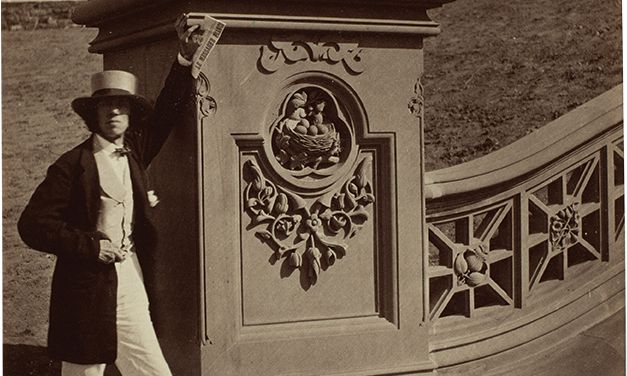Jacob Wrey Mould with his decorative designs for Bethesda Terrace in New York’s Central Park Courtesy of digitalcollections.nypl.org
Jacob Wrey Mould (1825-86) was one of a number of English architects who emigrated to the US in the 19th century, though he was unusual in having personal reasons to leave the country.
In London in 1841, Mould was apprenticed to Owen Jones, an architect best known as an authority on coloured decoration, who designed the colour scheme of the Great Exhibition building in 1851 and in 1856 published the influential Grammar of Ornament. Wanting more varied architectural experience, Mould joined the office of Lewis Vulliamy (1791-1871), and worked on the designs for R.S. Holford’s palatial Dorchester House (built 1853) in Park Lane. His passion for music and friendship with musicians led him to translate many opera libretti. (Mould’s description of himself as “hell on colour” and “sweet on song”—the title of this new biographical and architectural study—refers to his great interest in music.) He married, but got a shock when his wife’s sister turned up with her little niece. Who the child’s father was never emerged, but relations between Mould and his abusive wife became so fraught that he decided to emigrate, despite Jones’s warning that “the Americans will wring you out like a wet rag, then drop you like a hot potato”.
In 1852 Mould and his mother arrived in New York, welcomed by his uncle. He put forward a scheme for the decoration of the New York Crystal Palace, which was not accepted, but in 1853 he received an important commission for a new church for a Unitarian congregation moving north in Manhattan. In the Romanesque style, with a dome, it was remarkable for its alternating stripes of cream Normandy stone and red Philadelphia stone. It became known as “the Church of the Holy Zebra” (a taunt later levelled at Keble College, Oxford). Francis Kowsky gives an authoritative account of this striking building. Sadly its tall tower remained unbuilt, the congregation moved out in 1929 and the church was destroyed by fire in 1931. Mould later built several other churches, most of which have gone, but the grand First Presbyterian church at Bath, New York, survives, as do the charming little timber Unitarian Church at Yonkers and the pretty Episcopal church at Lake Luzerne, both also in New York State. His domestic work has also largely disappeared, though the Trinity Chapel Schoolhouse in New York is an effective piece of urban Gothic.
However, his work in Central Park is rightly emphasised by Kowsky, who has benefited from access to the detailed research undertaken by the late Lucille Gordon, a Central Park docent. Mould’s input was mostly done in collaboration with Calvert Vaux and Frederick Law Olmsted, and principally concerned the decoration of Bethesda Terrace, with the Angel Fountain, the richly carved piers, and above all the remarkable polychrome decoration of the “arcade”. Here he showed himself a true disciple of Jones. He made a considerable number of other designs for the park, some of which remained unexecuted.
In 1860 Mould married again, but in 1866 his first wife arrived in New York and began proceedings for divorce. Mould was ordered to pay alimony, which worsened his already calamitous financial situation. Furthermore, several of his acquaintances refused to believe that he was really married to his new partner and ostracised him.
There was a curious interlude in Mould’s career when he spent four years (1875-79) in Peru, working in the Office of Public Works under the patronage of the crooked railway entrepreneur Henry Meiggs. He was well paid, which had not been the case in New York, but his only substantial architectural work was the large Casa Dubois in Lima. Meiggs’s death in 1877 led to his decision to return to New York.
Mould died in 1886, having achieved less than he might have done. Even so, he well deserves Kowsky’s careful and perceptive account of his life and works. As the author of books on Vaux and on Olmsted, Vaux and the Buffalo Park System, as well as a biography of Frederick Clarke Withers (another architect who emigrated from Britain to New York), Kowsky is qualified for his subject.
• Francis R. Kowsky with Lucille Gordon, Hell on Color, Sweet on Song: Jacob Wrey Mould and the Artful Beauty of Central Park, Fordham University Press, 304pp, 120 colour and b/w illustrations, $39.95, published
30 May
• Peter Howell’s latest book is The Triumphal Arch (Unicorn Publishing 2021)

